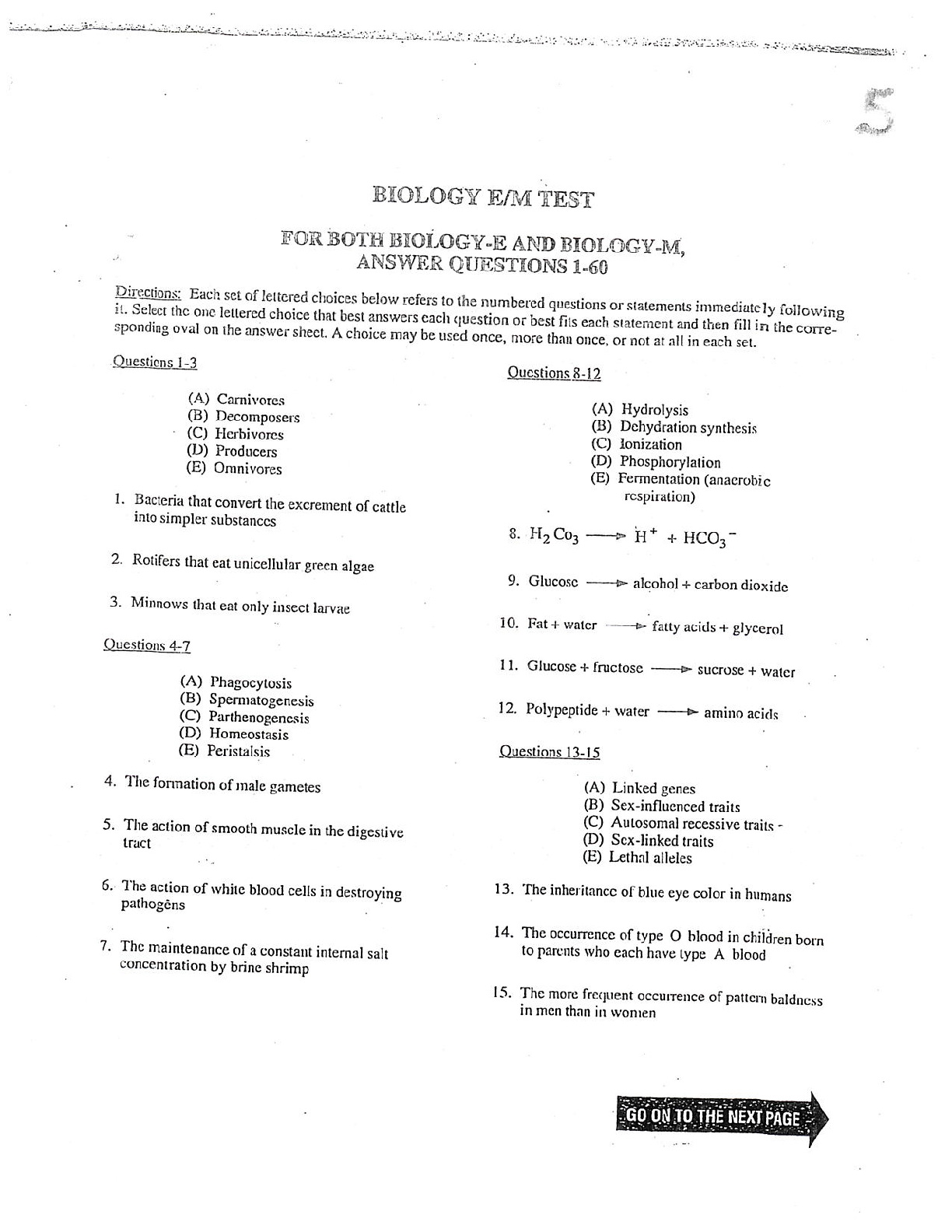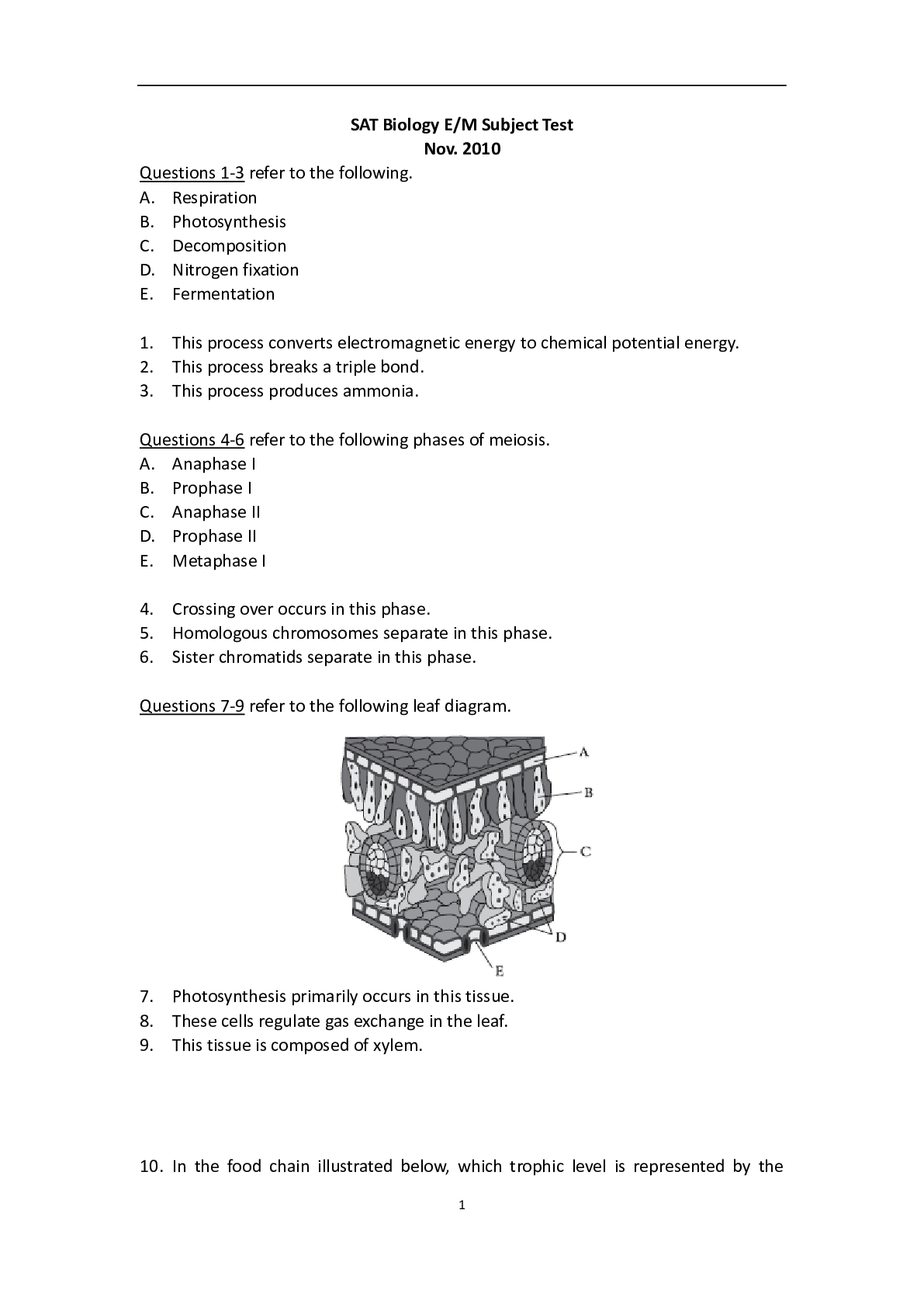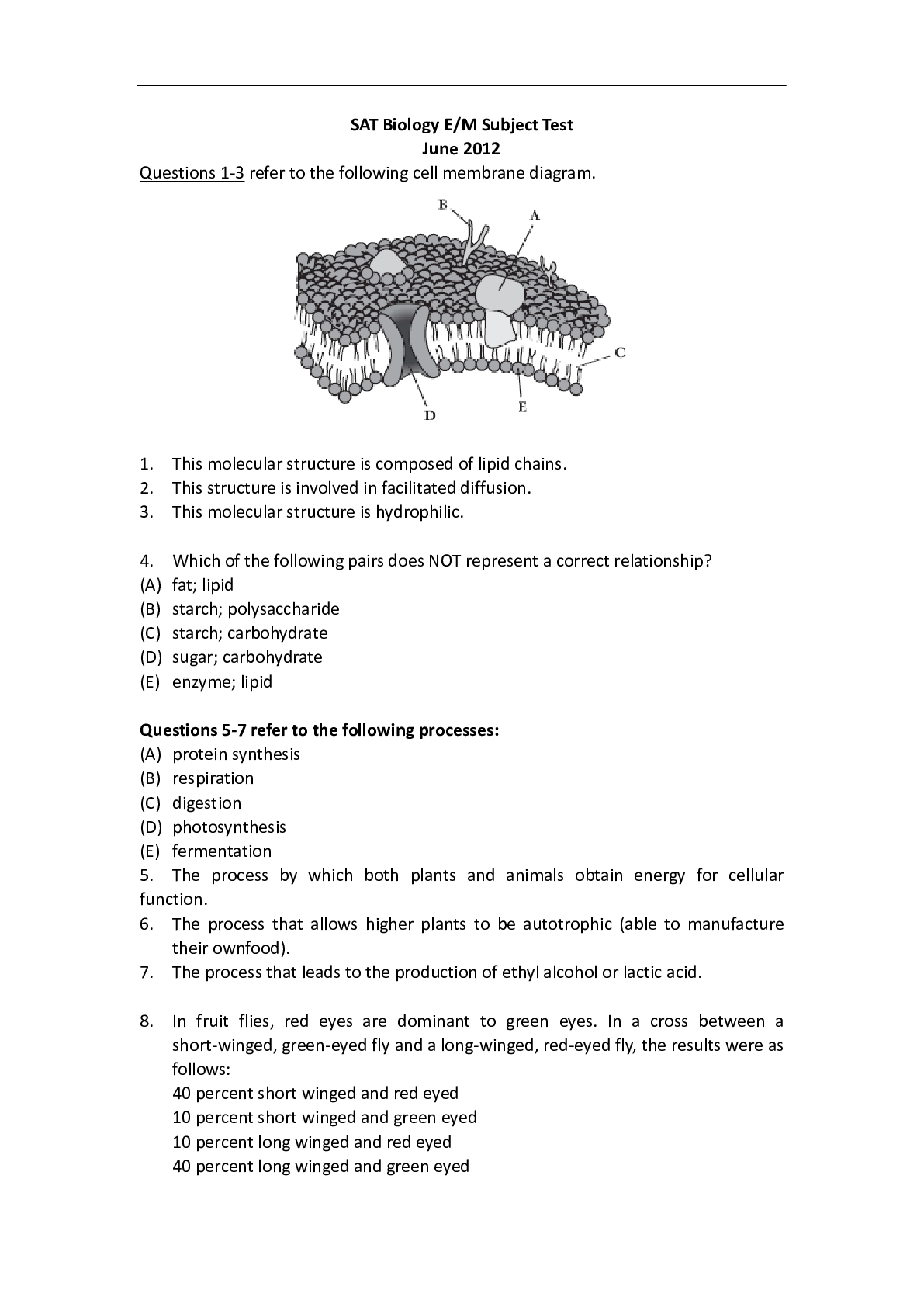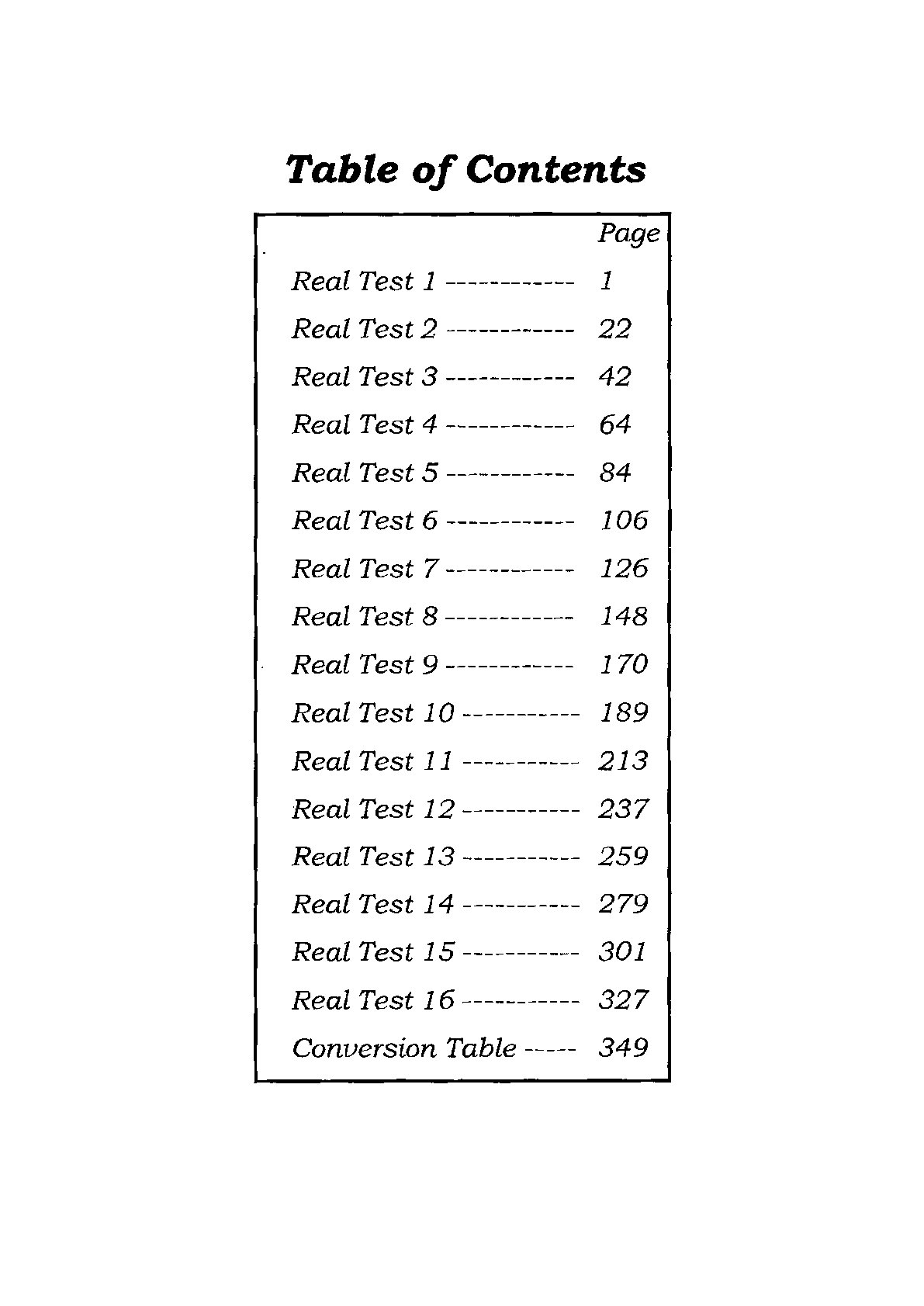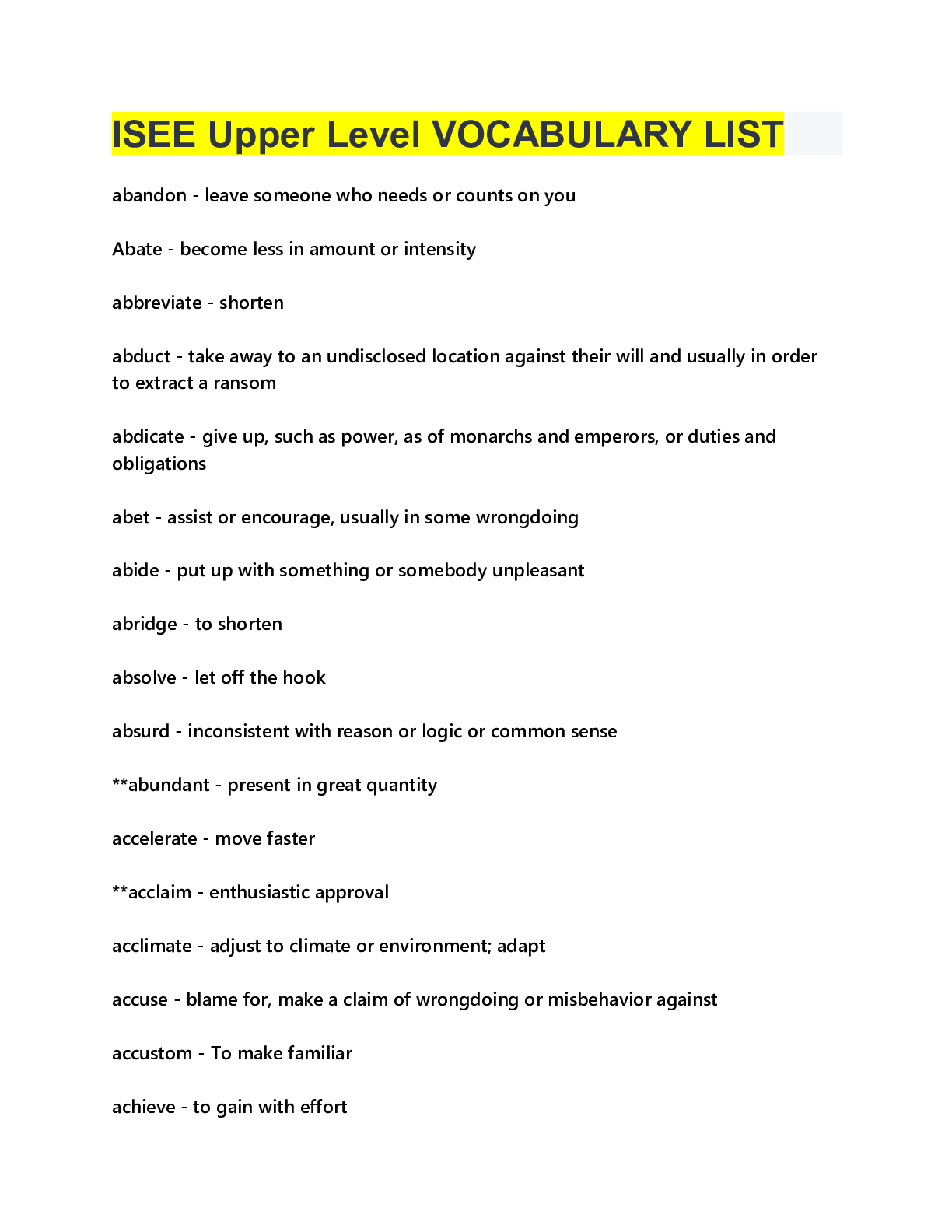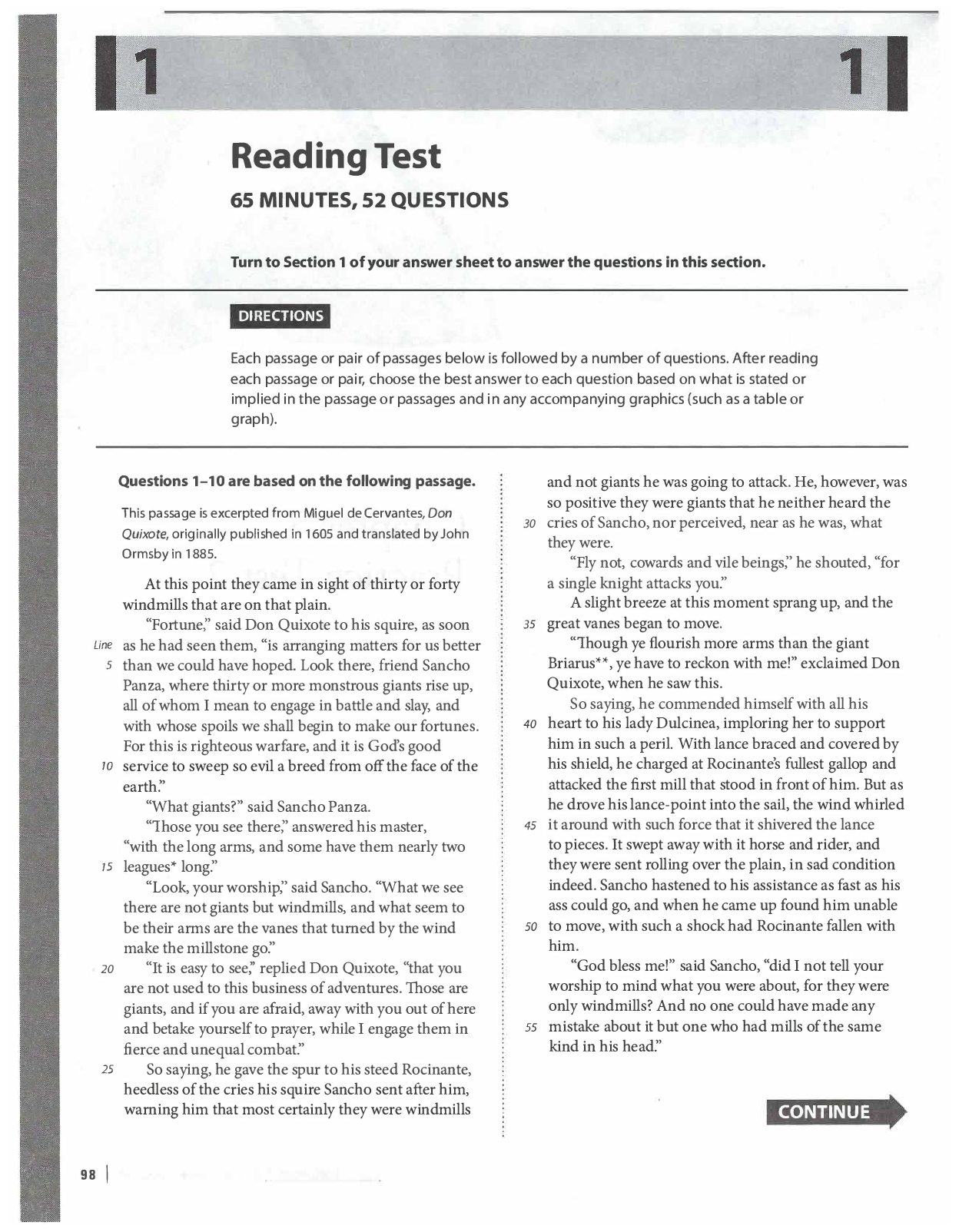SAT 2022 Reading Test. 52 Questions and Answer Key
Document Content and Description Below
SAT 2022 Reading Test. Questions and Answer Key 65 Minutes—52 Questions This section corresponds to Section 1 of your answer sheet. Directions Read each passage or pair of passages, then answer ... the questions that follow. Choose your answers based on what the passage(s) and any accompanying graphics state or imply. 1. 1. Questions 1–10 are based on the following passage. 2. The following passage is adapted from Leo Tolstoy’s 1873 novel, Anna Karenina (translated from the original Russian by Constance Garnett). Prior to this excerpt, one of the major characters, Levin, has realized that he is in love with his longtime friend Kitty Shtcherbatsky. At four o’clock, conscious of his throbbing heart, Levin stepped out of a hired sledge at the Zoological Gardens, and turned along the path to the frozen mounds and the skating ground, knowing that he would certainly find her there, as he had seen the Shtcherbatskys’ carriage at the entrance. It was a bright, frosty day. Rows of carriages, sledges, drivers, and policemen were standing in the approach. Crowds of well-dressed people, with hatsbright in the sun, swarmed about the entrance and along the well-swept little paths between the little houses adorned with carving in the Russian style. The old curly birches of the gardens, all their twigs laden with snow, looked as though freshly decked in sacred vestments. He walked along the path towards the skatingground, and kept saying to himself—“You mustn’t be excited, you must be calm. What’s the matter with you? What do you want? Be quiet, stupid,” he conjured his heart. And the more he tried to compose himself, the more breathless he found himself. An acquaintance met him and called him by his name, but Levin did not even recognize him. He went towards the mounds, whence came the clank of the chains of sledges as they slipped down or were dragged up, the rumble of the sliding sledges, and the sounds of merry voices. He walked on a few steps, and the skating-ground lay open before his eyes, and at once, amidst all the skaters, he knew her. He knew she was there by the rapture and the terror that seized on his heart. She was standing talking to a lady at the opposite end of the ground. There was apparently nothing striking either inher dress or her attitude. But for Levin she was as easy to find in that crowd as a rose among nettles. Everything was made bright by her. She was the smile that shed light on all round her. “Is it possible I can go over there on the ice, go up to her?” he thought. The place where she stood seemed to him a holy shrine, unapproachable, and there was one moment when he was almost retreating, so overwhelmed was he with terror. He had to make an effort to master himself, and to remind himself that people of all sorts were moving about her, and that he too might come there to skate. He walked down, for a long while avoiding looking at her as at the sun, but seeing her, as one does the sun, without looking. On that day of the week and at that time of day people of one set, all acquainted with one another, used to meet on the ice. There were crack skaters there, showing off their skill, and learners clinging to chairs with timid, awkward movements, boys, and elderly people skating with hygienic motives. They seemed to Levin an elect band of blissful beings because they were here, near her. All the skaters, it seemed, with perfect self-possession, skated towards her, skated by her, even spoke to her,and were happy, quite apart from her, enjoying the capital ice and the fine weather. Nikolay Shtcherbatsky, Kitty’s cousin, in a short jacket and tight trousers, was sitting on a garden seat with his skates on. Seeing Levin, he shouted to him: “Ah, the first skater in Russia! Been here long? First-rate ice—do put your skates on.” A3c. cording to the passage, how did Levin first know that Kitty was at the Zoological Gardens? 1. Kitty’s carriage was parked near the entrance. 2. Nikolay said he had been skating with Kitty earlier. 3. He saw her talking with another woman near the pond. 4. Kitty invited him to meet her there at a certain time. A4s. used in line 10, “swarmed” most nearly means 1. invaded. 2. gathered. 3. flew. 4. obstructed. T5h.e passage most strongly suggests that which of the following is true of Levin? 1. He worries about his appearance. 2. He wants Kitty to be more enthusiastic. 3. He is a very passionate person. 4. He is wary of his surroundings.W6.hich choice provides the best evidence for the answer to the previous question? 1. Lines 7–12 (“It was a bright, frosty day . . . in the Russian style”) 2. Lines 22–27 (“An acquaintance met him . . . merry voices”) 3. Lines 40–46 (“The place where . . . there to skate”) 4. Lines 50–55 (“On that day . . . hygienic motives”) W7.hat theme does the passage communicate through the experiences of Levin? 1. Love is a powerful emotion. 2. People long to have company. 3. Life should be filled with joy. 4. People are meant to work hard. T8h.e passage most strongly suggests that which of the following is true of how Levin appears to others? 1. People think that Levin looks agitated because of the way he is acting. 2. People think that Levin is sick because he seems to be feverish. 3. People think that Levin seems normal because he is doing nothing unusual. 4. People think that Levin is in trouble because he is not protecting himself emotionally. W9.hich choice provides the best evidence for the answer to theprevious question? 1. Lines 1–6 (“At four o’clock . . . at the entrance”) 2. Lines 9–12 (“Crowds . . . the Russian style”) 3. Lines 24–30 (“He went . . . he knew her”) 4. Lines 62–67 (“Nikolay Shtcherbatsky . . . your skates on”) 1A0s. used in line 20, “conjured” most nearly means 1. begged. 2. created. 3. summoned. 4. tricked. 1T1h.e author’s use of the word “throbbing” in line 1 implies that Levin 1. has cut himself badly. 2. has a sudden pain in his chest. 3. is about to collapse. 4. is in an agitated state. 1B2a.sed on the tone of this passage, what emotion does the author wish the reader to feel about Levin? 1. Empathy 2. Cynicism 3. Hostility 4. Disgust 2. 1. Questions 11–20 are based on the following passage. 2. This passage is adapted from a speech delivered by PresidentFranklin Roosevelt on January 6, 1941, to the United States Congress. In the passage, Roosevelt reveals his intention to preserve and spread American ideals around the world. The Nation takes great satisfaction and much strength from the things which have been done to make its people conscious of their individual stake in the preservation of democratic life in America. Those things have toughened the fibre of our people, have renewed their faith and strengthened their devotion to the institutions we make ready to protect. Certainly this is no time for any of us to stop thinking about the social and economic problems which are the root cause of the social revolution which is today a supreme factor in the world. For there is nothing mysterious about the foundations of a healthy and strong democracy. The basic things expected by our people of their political and economic systems are simple. They are: • Equality of opportunity for youth and for others. • Jobs for those who can work. • Security for those who need it. • The ending of special privilege for the few. • The preservation of civil liberties for all. • The enjoyment of the fruits of scientific progressin a wider and constantly rising standard of living. These are the simple, basic things that must never be lost sight of in the turmoil and unbelievable complexity of our modern world. The inner and abiding strength of our economic and political systems is dependent upon the degree to which they fulfill these expectations. Many subjects connected with our social economy call for immediate improvement. As examples: • We should bring more citizens under the coverage of old-age pensions and unemployment insurance. • We should widen the opportunities for adequate medical care. • We should plan a better system by which persons deserving or needing gainful employment may obtain it. I have called for personal sacrifice. I am assured of the willingness of almost all Americans to respond to that call. A part of the sacrifice means the payment of more money in taxes. In my Budget Message I shall recommend that a greater portion of this great defense program be paid for from taxation than we are paying today. No person should try, or beallowed, to get rich out of this program; and the principle of tax payments in accordance with ability to pay should be constantly before our eyes to guide our legislation. If the Congress maintains these principles, the voters, putting patriotism ahead of pocketbooks, will give you their applause. In the future days, which we seek to make secure, we look forward to a world founded upon four essential human freedoms. The first is freedom of speech and expression— everywhere in the world. The second is freedom of every person to worship God in his own way—everywhere in the world. The third is freedom from want—which, translated into world terms, means economic understandings which will secure to every nation a healthy peacetime life for its inhabitants— everywhere in the world. The fourth is freedom from fear—which, translated into world terms, means a world-wide reduction of armaments to such a point and in such a thorough fashion that no nation will be in a position to commit an act of physical aggression against any neighbor—anywhere in the world.That is no vision of a distant millennium. It is a definite basis for a kind of world attainable in our own time and generation. That kind of world is the very antithesis of the so-called new order of tyranny which the dictators seek to create with the crash of a bomb. To that new order we oppose the greater conception—the moral order. A good society is able to face schemes of world domination and foreign revolutions alike without fear. Since the beginning of our American history, we have been engaged in change—in a perpetual peaceful revolution—a revolution which goes on steadily, quietly adjusting itself to changing conditions—without the concentration camp or the quick-lime in the ditch. The world order which we seek is the cooperation of free countries, working together in a friendly, civilized society. This nation has placed its destiny in the hands and heads and hearts of its millions of free men and women; and its faith in freedom under the guidance of God. Freedom means the supremacy of human rights everywhere. Our support goes to those who struggle to gain those rights or keep them. Our strength is our unity of purpose. To that highconcept there can be no end save victory. T3h.e primary purpose of President Roosevelt’s speech is to 1. highlight the individuality inherent in patriotism. 2. define the basic needs of the country. 3. request money to support worthy causes. 4. promote support for essential human rights. W4.hich choice provides the best evidence for the answer to the previous question? 1. Lines 14–16 (“The basic things . . . are simple”) 2. Lines 30–31 (“Many subjects . . . improvement”) 3. Lines 52–54 (“If the Congress . . . applause”) 4. Lines 55–57 (“In the future days . . . freedoms”) A5s. used in line 40, “sacrifice” most nearly means 1. religious offerings to a deity. 2. service in the military. 3. losses of limbs in battle. 4. surrender of interests to a greater good. T6h.e passage most strongly suggests a relationship between which of the following? 1. Protection of human rights abroad and military service 2. Spread of freedom abroad and defense of democracy at home 3. Defeat of tyrants abroad and establishment of democratic government at home 4. Investment in global democracies abroad andstrengthening of patriotism at home W7.hich choice provides the best evidence for the answer to the previous question? 1. Lines 24–29 (“These are . . . expectations”) 2. Lines 52–54 (“If the Congress . . . applause”) 3. Lines 73–78 (“That is no . . . of a bomb”) 4. Lines 94–97 (“Freedom means . . . unity of purpose”) I8n.line 53, “pocketbooks” most nearly refers to 1. local, state, and national taxes. 2. war debt accumulated by the nation. 3. citizens’ individual monetary interests. 4. Americans’ personal investment in the defense industry. I9n.lines 73–75 (“That is no . . . generation”), President Roosevelt is most likely responding to what counterclaim to his own argument? 1. The spread of global democracy is idealistic and unrealistic. 2. The defeat of tyrannical dictators in Europe is implausible. 3. The commitment of the American people to the war effort is limited. 4. The resources of the United States are insufficient to wage war abroad. 1W0.hich choice offers evidence that the spread of global democracy is achievable? 1. Lines 47–48 (“No person . . . this program”)2. Lines 56–57 (“we look forward . . . human freedoms”) 3. Lines 83–84 (“Since the beginning . . . in change”) 4. Line 97 (“Our strength . . . purpose”) 1I1n.lines 62–66 (“The third is . . . world”), President Roosevelt sets a precedent by which he would most likely support which of the following policies? 1. Military defense of political borders 2. Investment in overseas business ventures 3. Aid to nations struggling due to conflict and other causes 4. Reduction of domestic services to spur job growth 1T2h.e function of the phrase “the so-called new order of tyranny” in line 76 is to 1. connect the global conflict for human rights to citizens on a personal level. 2. demonstrate the power of the global opposition to the United States. 3. present an alternative vision of the world without democracy. 4. provide examples of the political and social revolutions underway. 3. 1. Questions 21–31 are based on the following passage and supplementary material. 2. The United States Constitution has been amended 27 times since its ratification. Rights such as freedom of speech, religion, and press,for example, are granted by the First Amendment. This passage focuses on the Nineteenth Amendment, which gave women the right to vote. The American political landscape is constantly shifting on a myriad of issues, but the voting process itself has changed over the years as well. Electronic ballot casting, for example, provides the public with instantaneous results, and statisticians are more accurate than ever at forecasting our next president. Voting has always been viewed as an intrinsic American right and was one of the major reasons for the nation’s secession from Britain’s monarchical rule. Unfortunately, although all men were constitutionally deemed “equal,” true equality of the sexes was not extended to the voting booth until 1920. The American women’s suffrage movement began in 1848, when Elizabeth Cady Stanton and Lucretia Mott organized the Seneca Falls Convention. The meeting, initially an attempt to have an open dialogue about women’s rights, drew a crowd of nearly three hundred women and included several dozen men. Topics ranged from a woman’s role in society to law, but the issue of voting remained a contentious one. A freed slavenamed Frederick Douglass spoke eloquently about the importance of women in politics and swayed the opinion of those in attendance. At the end of the convention, one hundred people signed the Seneca Falls Declaration, which demanded “immediate admission to all the rights and privileges which belong to [women] as citizens of the United States.” Stanton and Mott’s first victory came thirty years later when a constitutional amendment allowing women to vote was proposed to Congress in 1878. Unfortunately, election practices were already a controversial issue, as unfair laws that diminished the African American vote had been passed during Reconstruction. Questionable literacy tests and a “vote tax” levied against the poor kept minority turnout to a minimum. And while several states allowed women to vote, federal consensus was hardly as equitable. The rest of the world, however, was taking note—and women were ready to act. In 1893, New Zealand allowed women the right to vote, although women could not run for office in New Zealand. Other countries began reviewing and ratifying their own laws as well. The United Kingdom took small steps by allowing married women to vote in local elections in 1894. By 1902,all women in Australia could vote in elections, both local and parliamentary. The suffrage movement in America slowly built momentum throughout the early twentieth century and exploded during World War I. President Woodrow Wilson called the fight abroad a war for democracy, which many suffragettes viewed as hypocritical. Democracy, after all, was hardly worth fighting for when half of a nation’s population was disqualified based on gender. Public acts of civil disobedience, rallies, and marches galvanized prowomen advocates while undermining defenders of the status quo. Posters read “Kaiser Wilson” and called into question the authenticity of a free country with unjust laws. The cry for equality was impossible to ignore and, in 1919, with the support of President Wilson, Congress passed the Nineteenth Amendment to the Constitution. It was ratified one year later by three-quarters of the states, effectively changing the Constitution. Only one signatory from the original Seneca Falls Declaration lived long enough to cast her first ballot in a federal election. America’s election laws were far from equal for all, as tactics to dissuade or prohibit AfricanAmericans from effectively voting were still routinely employed. However, the suffrage movement laid the groundwork for future generations. Laws, like people’s minds, could change over time. The civil rights movement in the mid- to late-twentieth century brought an end to segregation and so-called Jim Crow laws that stifled African American advancement. The Voting Rights Act of 1965 signaled the end of discriminatory voting laws; what emerged was a free nation guided by elections in which neither skin color nor gender mattered, but only the will of all citizens. T3h.e stance the author takes in the passage is best described as thatof 1. an advocate of women’s suffrage proposing a constitutional amendment. 2. a legislator reviewing the arguments for and against women’s suffrage. 3. a scholar evaluating the evolution and impact of the women’s suffrage movement. 4. a historian summarizing the motivations of women’s suffrage leaders. L4i.nes 71–72 (“America’s election laws . . . equal for all”) most clearly support which claim? 1. The founders of the Constitution did not provide for free and fair elections. 2. The United States still had work to do to secure equal voting rights for some people. 3. Most women in the United States did not want suffrage and equal rights. 4. The women’s suffrage movement perpetuated discriminatory voting laws. W5.hich choice provides the best evidence for the answer to the previous question? 1. Lines 14–15 (“The American . . . in 1848”) 2. Lines 42–43 (“In 1893 . . . to vote”) 3. Lines 64–65 (“Congress . . . the Constitution”) 4. Lines 80–81 (“The Voting Rights Act . . . voting laws”)A6s. used in line 58, “galvanized” most nearly means 1. displaced. 2. divided. 3. excited. 4. organized. T7h.e function of lines 76–77 (“Laws, like . . . could change”) is to 1. connect the success of legislative reform with shifts in public sentiment. 2. dissuade reformers from focusing on grassroots activity rather than political campaigns. 3. evaluate the effectiveness of judicial rulings based on popular response to public polls. 4. reject the need for legal actions and court proceedings to attain social change. T8h.e passage most strongly suggests that 1. the American government adapts to the changing needs and ideas of society. 2. the best-organized reform movements are most likely to achieve their goals. 3. the nation is more vulnerable to change during the confusion of wartime. 4. the civil rights movement would not have happened without women suffragists. W9.hich choice provides the best evidence for the answer to the previous question?1. Lines 4–7 (“Electronic ballot casting . . . our next president”) 2. Lines 7–10 (“Voting has . . . monarchical rule”) 3. Lines 17–20 (“The meeting . . . dozen men”) 4. Lines 77–80 (“The civil rights . . . advancement”) 1T0h.e graphic most clearly illustrates which idea? 1. The Nineteenth Amendment happened as a result of World War I. 2. The states slowed reform of national voting rights laws. 3. Women’s suffrage resulted from a slow evolution of events. 4. Acts of civil disobedience won support for suffrage in Congress. 1I1n.line 61, the word “authenticity” most nearly means 1. reliability. 2. realism. 3. legitimacy. 4. truth. 1T2h.e passage suggests that President Wilson contributed to the success of the women’s suffrage movement by 1. circulating government propaganda in support of women’s suffrage. 2. framing the fight in World War I as a fight for democracy and freedom. 3. engaging in a foreign war to distract the nation frompolitical debate. 4. working with legislators to write the Nineteenth Amendment. 1T3h.e graphic helps support which statement referred to in the passage? 1. Early women suffragists did not live to vote in national elections. 2. The Nineteenth Amendment passed within a few years of its introduction. 3. A majority of state representatives opposed women’s suffrage in 1918. 4. Many state governments approved suffrage before the federal government did. 4. 1. Questions 32–42 are based on the following passages and supplementary material. 2. Passage 1 is about how scientists use radioisotopes to date artifacts and remains. Passage 2 discusses the varying problems with radioactive contaminants. Passage 1 Archaeologists often rely on measuring the amounts of different atoms present in an item from a site to determine its age. The identity of an atom depends on how many protons it has in its nucleus; forexample, all carbon atoms have 6 protons. Each atom of an element, however, can have a different number of neutrons, so there can be several versions, or isotopes, of each element. Scientists name the isotopes by the total number of protons plus neutrons. For example, a carbon atom with 6 neutrons is carbon-12 while a carbon atom with 7 neutrons is carbon-13. Some combinations of protons and neutrons are not stable and will change over time. For example, carbon-14, which has 6 protons and 8 neutrons, will slowly change into nitrogen-14, with 7 protons and 7 neutrons. Scientists can directly measure the amount of carbon-12 and carbon-14 in a sample or they can use radiation measurements to calculate these amounts. Each atom of carbon-14 that changes to nitrogen-14 emits radiation. Scientists can measure the rate of emission and use that to calculate the total amount of carbon-14 present in a sample. Carbon-14 atoms are formed in the atmosphere at the same rate at which they decay. Therefore, the ratio of carbon-12 to carbon-14 atoms in the atmosphere is constant. Living plants and animals have the same ratio of carbon-12 to carbon-14 in their tissues because they are constantly taking in carbon in the form of food or carbon dioxide. Afterthe plant or animal dies, however, it stops taking in carbon and so the amount of carbon-14 atoms in its tissues starts to decrease at a predictable rate. By measuring the ratio of carbon-12 to carbon-14 in a bone, for example, a scientist can determine how long the animal the bone came from has been dead. To determine an object’s age this way is called “carbon-14 dating.” Carbon-14 dating can be performed on any material made by a living organism, such as wood or paper from trees or bones and skin from animals. Materials with ages up to about 50,000 years old can be dated. By finding the age of several objects found at different depths at an archeological dig, the archeologists can then make a timeline for the layers of the site. Objects in the same layer will be about the same age. By using carbon dating for a few objects in a layer, archeologists know the age of other objects in that layer, even if the layer itself cannot be carbon dated. Passage 2 Radioactive materials contain unstable atoms that decay, releasing energy in the form of radiation. The radiation can be harmful to living tissue because it can penetrate into cells and damage their DNA. If an explosion or a leak at a nuclear power plantreleases large amounts of radioactive materials, the surrounding area could be hazardous until the amount of radioactive material drops back to normal levels. The amount of danger from the radiation and the amount of time until the areas are safe again depends on how fast the materials emit radiation. Scientists use the “half-life” of a material to indicate how quickly it decays. The half-life of a material is the amount of time it takes for half of a sample of that material to decay. A material with a short halflife decays more quickly than a material with a long half-life. For example, iodine-131 and cesium-137 can both be released as a result of an accident at a nuclear power plant. Iodine-131 decays rapidly, with a half-life of 8 days. Cesium-137, however, decays more slowly, with a half-life of 30 years. If an accident releases iodine-131, therefore, it is a short-term concern. The amount of radiation emitted will be high but will drop rapidly. After two months, less than one percent of the original iodine-131 will remain. An accidental release of cesium-137, however, is a long-term concern. The amount of radiation emitted at first will be low but will drop slowly. It will take about 200 years for the amount of cesium-137 remaining to drop below one percent.The total amount of radiation emitted in both cases will be the same, for the same amount of initial material. The difference lies in whether the radiation is all released rapidly at high levels in a short time, or is released slowly at low levels, over a long time span. B3a.sed on the information in Passage 1, which of the following could be dated using carbon-14 dating? 1. An iron pot found in a cave 2. A rock at the bottom of a quarry 3. An arrowhead made from bone 4. The remains of a house made from stone W4.hich choice provides the best evidence for the answer to the previous question?1. Lines 9–11 (“For example . . . carbon-13”) 2. Lines 26–29 (“Living plants . . . dioxide”) 3. Lines 29–32 (“After the plant . . . rate”) 4. Lines 37–40 (“Carbon-14 dating . . . animals”) A5s. used in line 24, “decay” most nearly means 1. yield. 2. deteriorate. 3. discharge. 4. circulated. W6.hich statement best describes the relationship between carbon-12 and carbon-14 in living tissue? 1. There is more carbon-14 than carbon-12. 2. There is more carbon-12 than carbon-14. 3. The ratio of carbon-12 to carbon-14 is constant. 4. The ratio of carbon-12 to carbon-14 fluctuates greatly. W7.hich choice provides the best evidence for the answer to the previous question? 1. Lines 12–13 (“Some combinations . . . time”) 2. Lines 23–24 (“Carbon-14 atoms . . . decay”) 3. Lines 26–29 (“Living plants . . . carbon dioxide”) 4. Lines 29–32 (“After the plant . . . rate”) I8n. Passage 2, the author refers to an accident that results in the release of iodine-131 as a “short-term concern” (line 71) because the initial amount of radiation released is 1. low but will drop slowly.2. high but will drop quickly. 3. low and will drop quickly. 4. high and will drop slowly. A9c. cording to Passage 2, living tissue exposed to radioactive material can 1. be destroyed by high levels of heat caused by the radiation. 2. become radioactive itself and damage surrounding tissue. 3. suffer injury when the cells’ components are damaged. 4. be killed by extra protons released by the radioactive material. 1A0s. used in line 73, “original” most nearly means 1. earliest. 2. unique. 3. unusual. 4. critical. 1A1c. cording to Passage 2, scientists use the half-life of radioactive material to determine the 1. amount of danger posed by radiation immediately following a nuclear accident. 2. likelihood of a nuclear accident involving the release of radioactive material at any given location. 3. amount of radiation contained in a sample of iodine-131 or cesium-137 used in nuclear reactions. 4. length of time that must pass until an area is safe after therelease of radioactive material. 1W2.hich generalization about the study of physics is supported by both passages? 1. The study of atomic and nuclear physics can have many applications in a variety of fields. 2. The study of physics has helped revolutionize how archaeologists study artifacts. 3. Scientists use physics to keep people and wildlife safe following a nuclear accident. 4. Scientists use different concepts to date ancient items and assess danger from nuclear accidents. 1B3a.sed on the graph and the information in the passages, which statement is accurate? 1. Carbon-14 has a half-life of about 5,400 years. 2. The half-life of carbon-14 is similar to that of cesium-137. 3. The half-life of iodine-131 is greater than that of cesium- 137. 4. All radioactive materials have a half-life of 30 to 5,400 years. 5. 1. Questions 43–52 are based on the following passage and supplementary material. 2. The following passage is adapted from an essay about the field of biomimicry, which focuses on the design of materials and systems that are based on biological structures.In 1948, Swiss chemist George de Mestral was impressed with the clinging power of burrs snagged in his dog’s fur and on his pant legs after he returned from a hike. While examining the burrs under a microscope, he observed many hundreds of small fibers that grabbed like hooks. He experimented with replicas of the burrs and eventually invented Velcro®, a synthetic clinging fabric that was first marketed as “the zipperless zipper.” In the 1960s, NASA used de Mestral’s invention on space suits, and now, of course, we see it everywhere. You might say that de Mestral was the father of biomimicry, an increasingly essential field that studies nature, looking for efficiencies in materials and systems, and asks the question “How can our homes, our electronics, and our cities work better?” As one biomimetics company puts it: “Nature is the largest laboratory that ever existed and ever will.” Architecture is one field that is constantly exploring new ways to incorporate biomimicry. Architects have studied everything from beehives to beaver dams to learn how to best use materials, geometry, and physics in buildings. Termite mounds, for example, very efficiently regulatetemperature, humidity, and airflow, so architects in Zimbabwe are working to apply what they’ve learned from termite mounds to human-made structures. Says Michael Pawlyn, author of Biomimicry in Architecture, “If you look beyond the nice shapes in nature and understand the principles behind them, you can find some adaptations that can lead to new, innovative solutions that are radically more resource-efficient. It’s the direction we need to take in the coming decades.” Designers in various professional fields are drawing on biomimicry; for example, in optics, scientists have examined the surface of insect eyes in hopes of reducing glare on handheld device screens. Engineers in the field of robotics worked to replicate the property found in a gecko’s feet that allows adhesion to smooth surfaces. Sometimes what scientists learn from nature isn’t more advanced, but simpler. The abalone shrimp, for example, makes its shell out of calcium carbonate, the same material as soft chalk. It’s not a rare or complex substance, but the unique arrangement of the material in the abalone’s shell makes it extremely tough. The walls of the shellcontain microscopic pieces of calcium carbonate stacked like bricks, which are bound together using proteins just as concrete mortar is used. The result is a shell three thousand times harder than chalk and as tough as Kevlar® (the material used in bulletproof vests). Often it is necessary to look at the nanoscale structures of a living material’s exceptional properties in order to re-create it synthetically. Andrew Parker, an evolutionary biologist, looked at the skin of the thorny devil (a type of lizard) under a scanning electron microscope, in search of the features that let the animal channel water from its back to its mouth. Examples like this from the animal world abound. Scientists have learned that colorful birds don’t always have pigment in their wings but are sometimes completely brown; it’s the layers of keratin in their wings that produce color. Different colors, which have varying wavelengths, reflect differently through keratin. The discovery of this phenomenon can be put to use in creating paints and cosmetics that won’t fade or chip. At the same time, paint for outdoor surfaces can be made tougher by copying the structures found in antler bone. Hearing aids are being designed to capturesound as well as the ears of the Ormia fly do. And why can’t we have a self-healing material like our own skin? Researchers at the Beckman Institute at the University of Illinois are creating just that; they call it an “autonomic materials system.” A raptor’s feathers, a whale’s fluke, a mosquito’s proboscis—all have functional features we can learn from. The driving force behind these innovations, aside from improved performance, is often improved energy efficiency. In a world where nonrenewable energy resources are dwindling and carbon emissions threaten the planet’s health, efficiency has never been more important. Pawlyn agrees: “For me, biomimicry is one of the best sources of innovation to get to a world of zero waste because those are the rules under which biological life has had to exist.” Biomimicry is a radical field and one whose practitioners need to be radically optimistic, as Pawlyn is when he says, “We could use natural products such as cellulose, or even harvest carbon from the atmosphere to create bio-rock.” Tiny florets in a sunflower’s center are arranged in an interlocking spiral, which inspired engineers in the design of this solar power plant. Mirrors positionedat the same angle as the florets bounce light toward the power plant’s central tower. Adapted from David Ferris, “Innovate: Solar Designs from Nature.” © 2014 by Sierra Club. T3h.e central focus of the passage is 1. the field of biomimicry, which is the study of materials and systems found in nature and replicated in ways that benefit people. 2. the work of George de Mestral, the Swiss chemist who invented Velcro® after observing burrs under a microscope. 3. the ways in which architects use termite mounds as models for human-made structures in Zimbabwe. 4. how scientists are seeking ways to improve energy efficiency as nonrenewable energy sources decline. W4.hich choice provides the best evidence for the answer to the previous question? 1. Lines 1–6 (“In 1948 . . . hooks”) 2. Lines 13–19 (“You might say . . . ever will’”) 3. Lines 24–29 (“Termite mounds . . . structures”) 4. Lines 84–89 (“The driving . . . more important”) T5h.e author includes a quote in paragraph 4 in order to 1. explain why architects are looking to biomimicry for solutions in architecture. 2. provide an argument for more scientists to study biomimicry.3. give an explanation as to why someone might choose a career in architecture. 4. provide a counterargument to the author’s central claim. B6a.sed on the information in paragraph 6, how does the shell of an abalone shrimp compare with soft chalk? 1. The essential building blocks are arranged in a similar manner, but the material that makes up the shell of an abalone shrimp is harder. 2. Both are made from the same essential building blocks, but the shell of the abalone shrimp is much harder because of the manner in which the materials are arranged. 3. The essential building blocks of both are the same, but the abalone shrimp shell is harder because the soft chalk lacks a protein binding the materials together. 4. They are made from different essential building blocks, but they have a similar hardness because the materials are arranged in a similar manner. I7n.paragraph 9, what is the function of the quote from Pawlyn about efficiency? 1. To convince readers that Pawlyn is an expert in his field 2. To prove that great strides are being made in creating products that do not generate waste 3. To demonstrate the limits of what biomimicry can achieve 4. To support the statement that energy efficiency “has never been more important”I8n.line 32, “principles” most nearly means 1. sources. 2. attitudes. 3. standards. 4. concepts. O9f. the following, the most reasonable inference from the passage is that 1. more scientists will utilize solutions developed through biomimicry in the future. 2. the field of biomimicry will eventually decline as more nonrenewable resources are discovered. 3. scientists will leave the fields they are currently working in and begin research in biomimicry. 4. doctors will create a self-healing skin called an “autonomic materials system” using methods based in biomimicry. 1W0.hich choice provides the best evidence for the answer to the previous question? 1. Lines 37–41 (“Designers . . . screens”) 2. Lines 57–59 (“Often it is . . . synthetically”) 3. Lines 65–69 (“Examples like . . . color”) 4. Lines 94–98 (“Biomimicry . . . bio-rock”) 1A1s. used in line 92, “radical” most nearly means 1. pervasive. 2. drastic.3. essential. 4. revolutionary. 1T2h.e graphic and caption that accompany this passage help illustrate how biomimicry can be used to 1. make a solar plant more attractive. 2. increase waste generated by energy sources. 3. improve the efficiency of existing technologies. 4. replicate a pattern common in nature. If you finish before time is called, you may check your work on this section only. Do not turn to any other section in the test. ANSWER KEY [Show More]
Last updated: 1 year ago
Preview 1 out of 38 pages
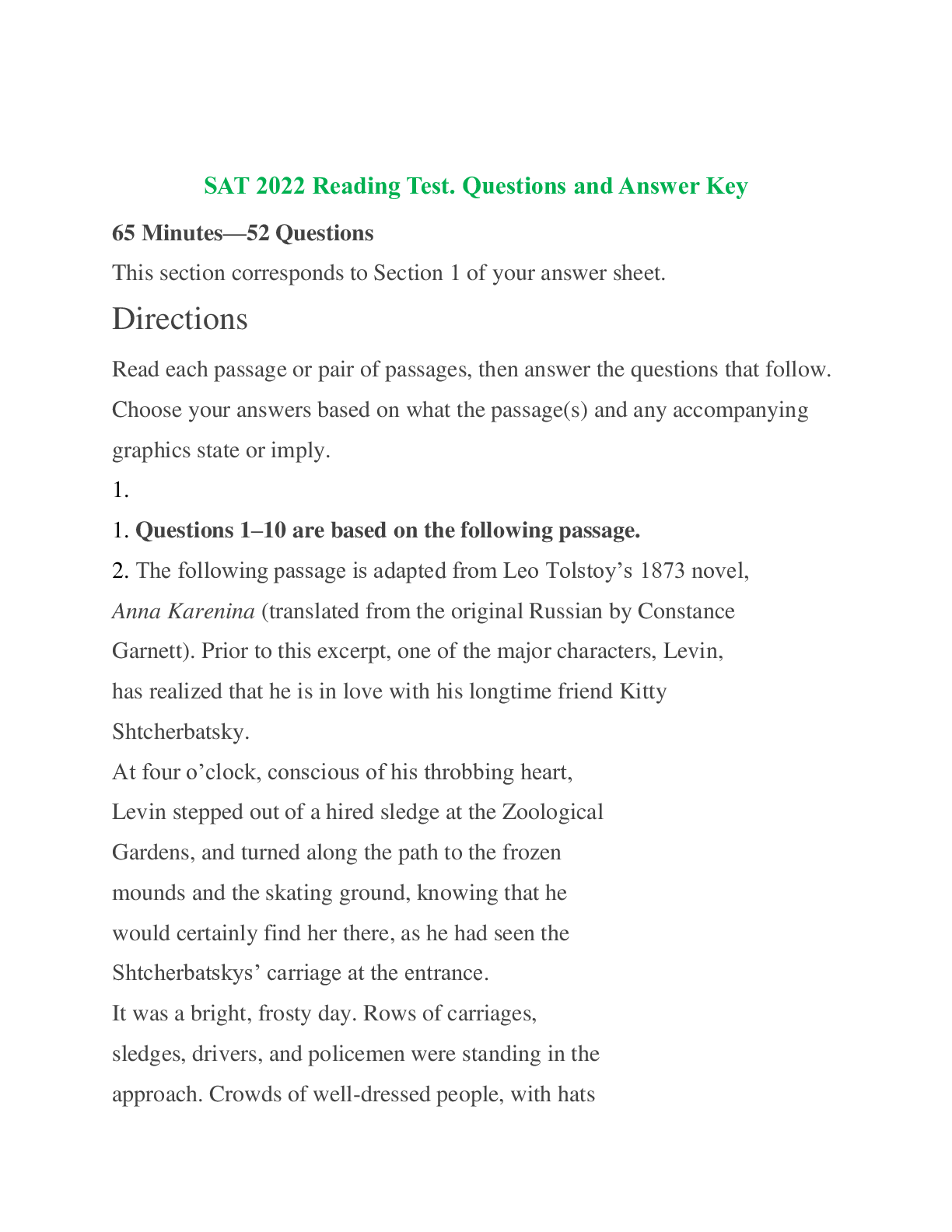
Reviews( 0 )
Document information
Connected school, study & course
About the document
Uploaded On
Oct 29, 2022
Number of pages
38
Written in
Additional information
This document has been written for:
Uploaded
Oct 29, 2022
Downloads
0
Views
192

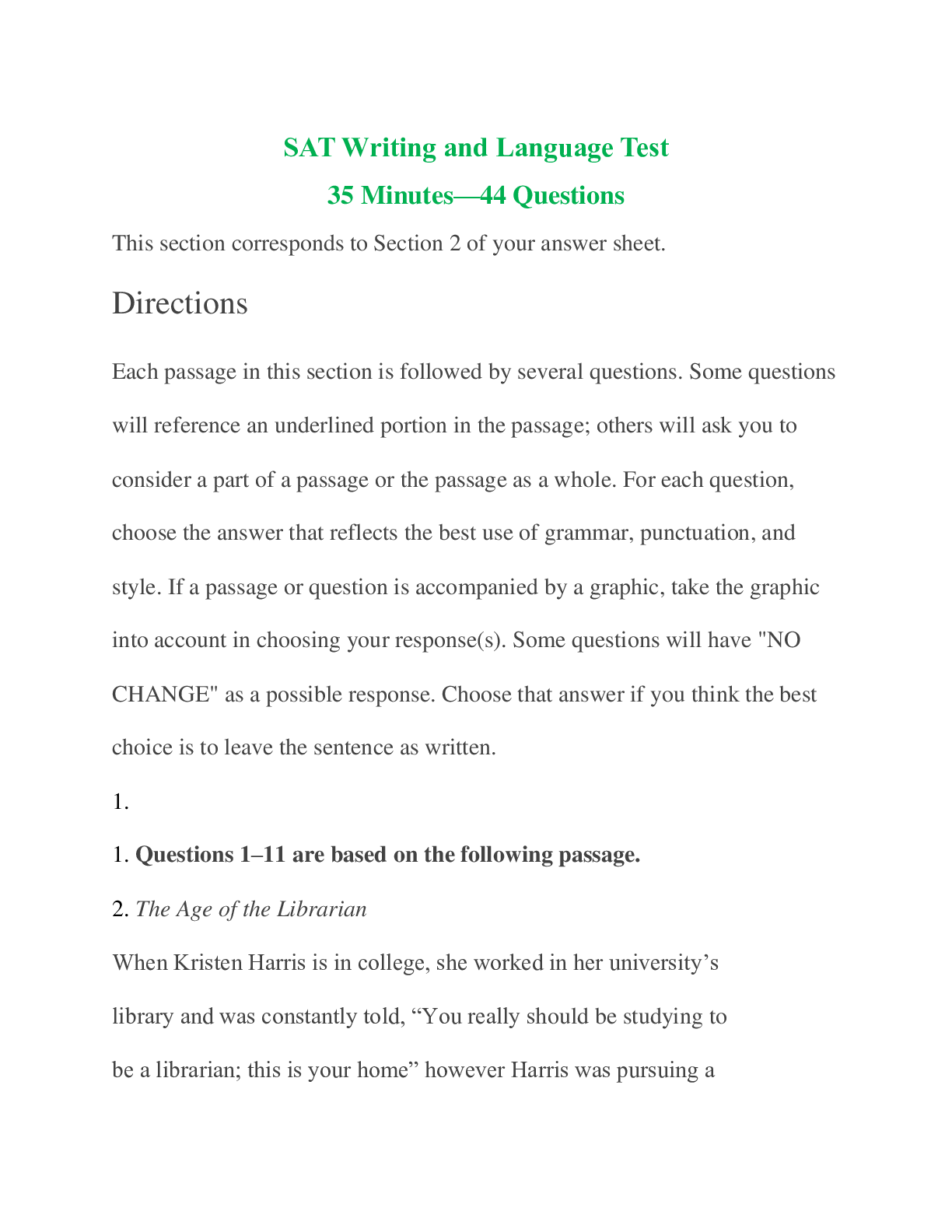
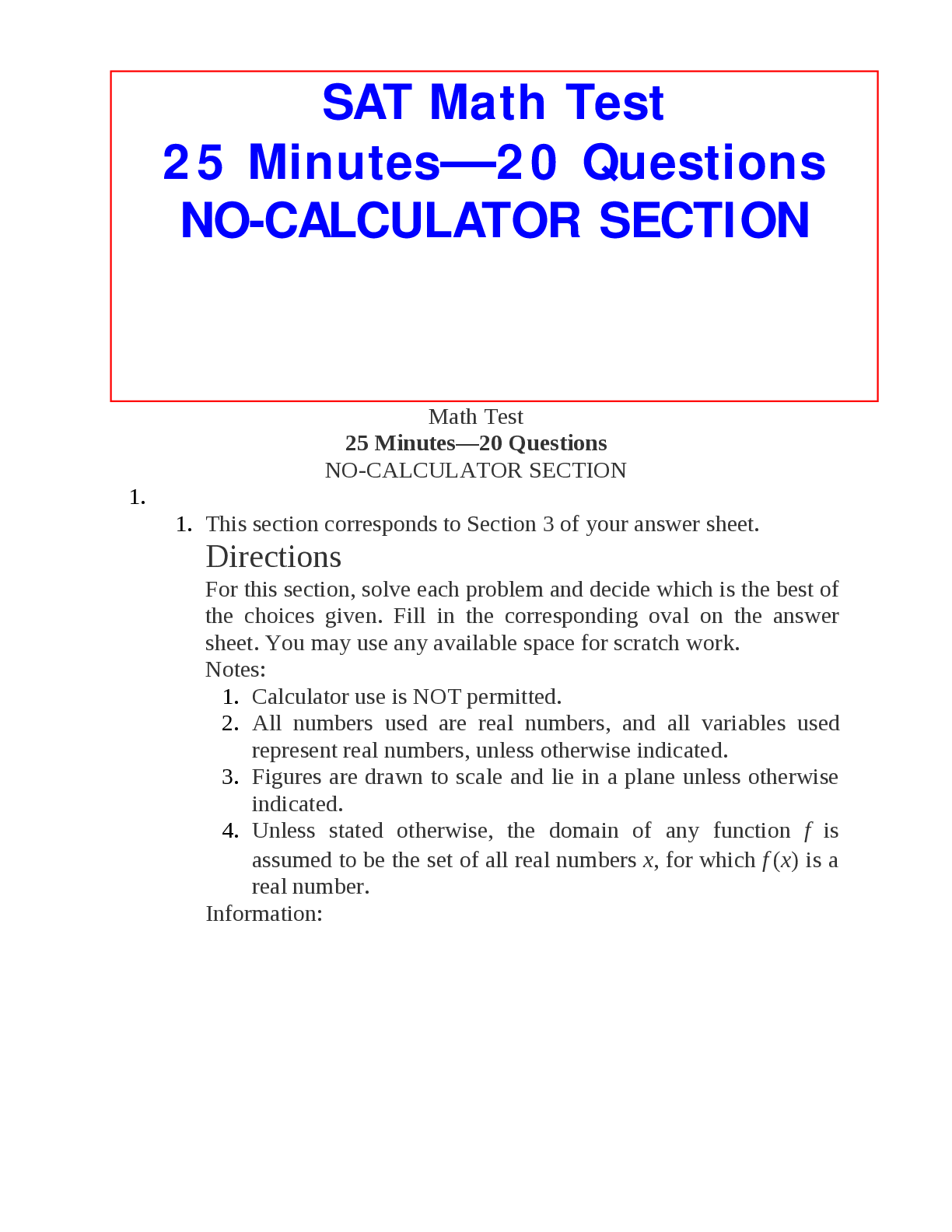
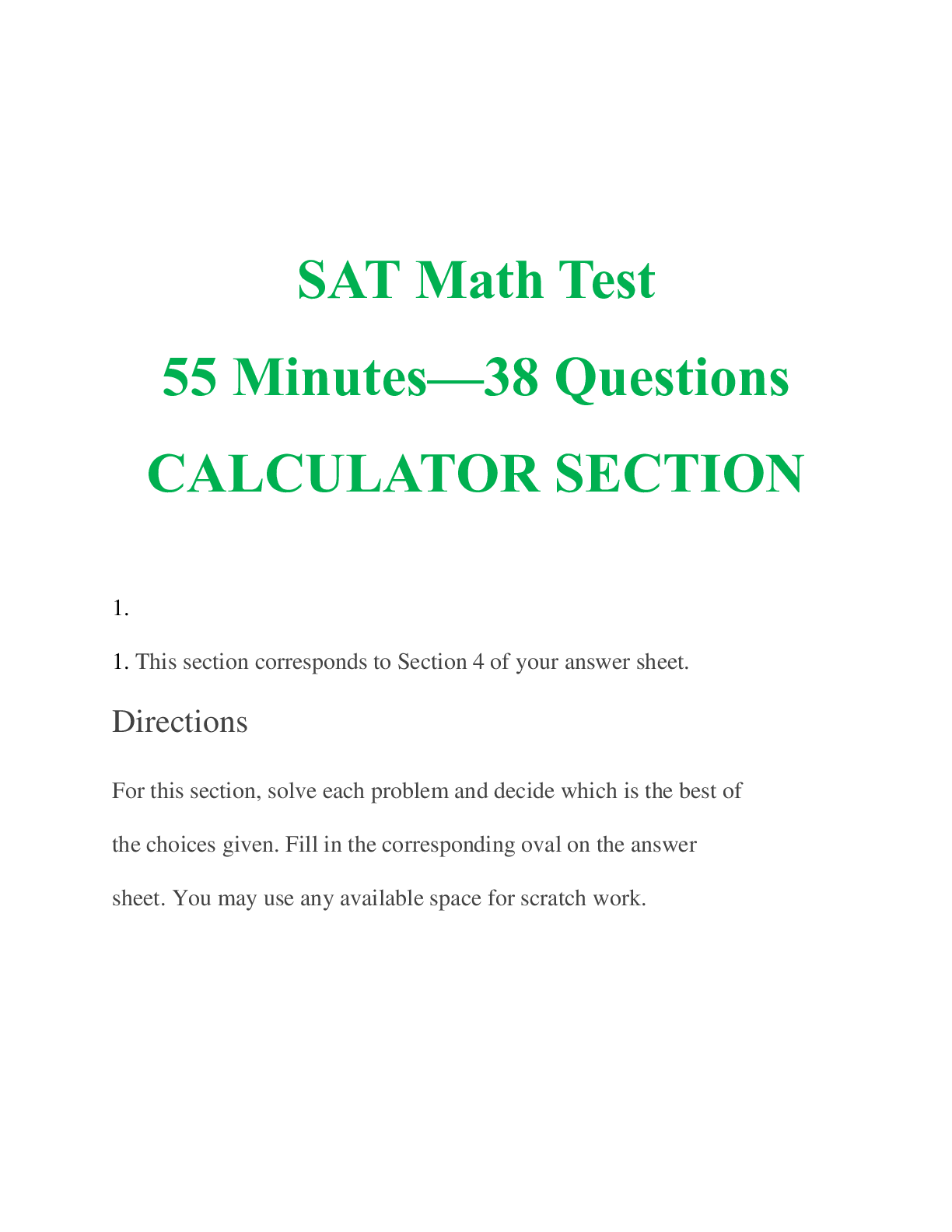
 Questions and Answers 100% VERIFIED.png)
 Questions and Answers 100% correct Solutions.png)
